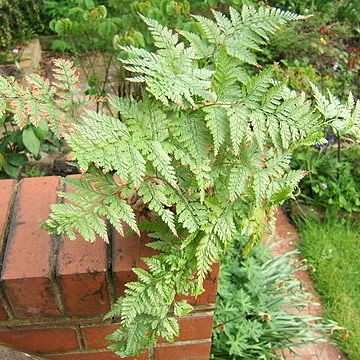Plants moderate-sized, epiphytic or sometimes terrestrial. Rhizome long creeping, with dark, peltate scales. Fronds remote, long stipitate, monomorphic or dimorphic; stipe articulate to short phyllopodia, terete or slightly winged; lamina bipinnate to 4-pinnate-pinnatifid, deltoid or pentagonal, firmly leathery or sometimes thickly herbaceous, glabrous; ultimate segments with crenate or lobed margins. Veins free, usually forked, terminating in lobes or crenations of cartilaginous margin. Sori terminal on veins, on small oblique lobes or crenations; indusium extrorse, elongate toward margin, attached at base and sides, long stalked; annulus longitudinal, consisting of ca. 14 thickened cells; spores monolete, elliptic, smooth, translucent; perispore absent. n = 10, (40).
Epiphytic, lithophytic or terrestrial ferns. Rhizome long-creeping, bearing tapering elongate scales with peltate bases. Fronds markedly dimorphic in some species. Stipes scattered along the rhizome and articulated to it; stipe and rachis usually grooved on upper surface. Lamina deeply lobed and variously dissected; pinnae (where present) not articulated to rachis; venation open, simple or forked; hydathodes absent. Sori superficial, near or at margins of ultimate lobes, associated with vein endings; indusium semi-circular or elongate. Spores ellipsoidal; surface variously ornamented.
Sori terminal on veinlets; indusium elongate, attached by base and sides. Sporangia long-stalked; annulus incomplete, vertical; spores oblong-reniform, hyaline. Rhizome elongate, dictyostelic; paleae ciliate; stipes articulated to rhizome; lamina decompound, coriac.; veins free. About 40 epiphytic spp., mostly of E. Asia and Polynesia, but extending to Madagascar, Natal and N.Z.
Fronds more copiously branched

